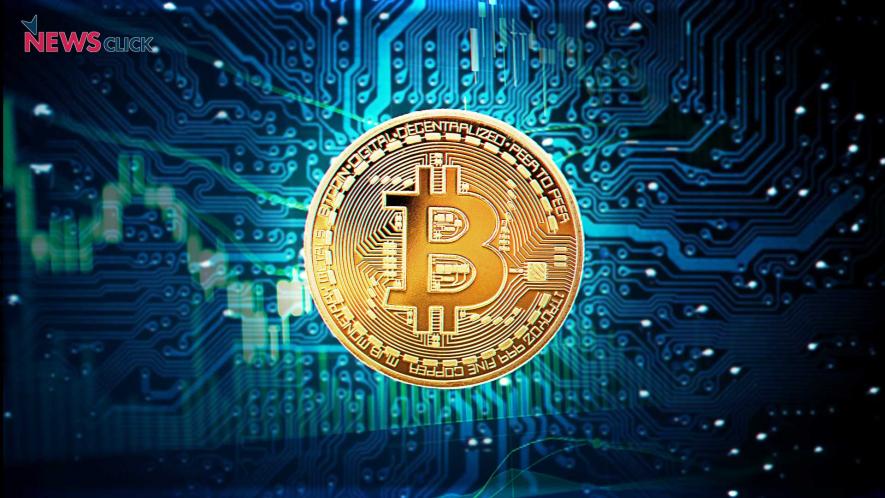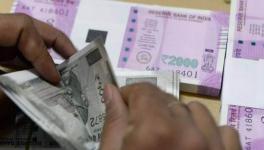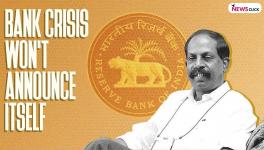The Face Value of Bitcoin: Proof of Work and the Labour Theory of Value

Newsclick Image by Nitesh Kumar
Bitcoin was created to be a new kind of money rooted in a vision of a market not bound by geography, banks and governments. Despite the intentions of its creators, Bitcoin is not money. It was designed with a faulty understanding of money, and as a result has a bug, a kind of a short circuit that kick-started an asset bubble and that will eventually turn Bitcoin into a toxic asset. In order to to fix this bug we need to employ the labour theory of value.
Writing at New Economic Perspectives, Eric Tymoigne, a research associate at the Levy Economics Institute, argues that the fair price of Bitcoin is zero.
Tymoigne's reasoning is based on the the fact that money is a financial instrument. The value of a financial instrument can come from being redeemable to its issuer, from providing an income stream or from having a collateralized value. For example US Dollars are redeemable against taxes. Bonds bear interest and stocks pay dividends. Gold coins contain gold, which can be sold as a commodity.
Since Bitcoin is not redeemable, provides no income and has no collateralized value, it is worthless as a financial instrument. Thus, its "fair price" is zero. Eric concludes that "Bitcoins are purely speculative assets."
From the point of view of modern finance, Bitcoin is not money at all.
The inventor of Bitcoin, Satoshi Nakamoto, did set out to create a new kind of money. The very first words of the Bitcoin whitepaper state that a "purely peer-to-peer version of electronic cash would allow online payments to be sent directly from one party to another without going through a financial institution."
Bitcoin is intended to be money. A different kind of money. A form of money that is not a financial instrument issued by a bank or government, as Tymoigne understands it, but a form of money that is independent of financial institutions, governments and all other intermediaries.
Bitcoin is intended to be a kind of money that can be used to make payments across the internet in a way that makes government unnecessary and doesn't reveal real names or physical locations. As such, it does not have properties that would tie it to an issuer who could redeem it, or provide a money income, or be collateralized with a physical commodity. Decentralized money can not have the properties on which Eric Tymoigne bases fair price.
The economic school most associated with the Bitcoin community is the Austrian school, especially its libertarian capitalist adherents. This school views money as being firmly rooted in what Tymoigne refers to as its collateralized value, i.e. the gold content in a gold coin, what Austrian-influenced economists call "sound money."
While the modern finance view holds that even with gold coins, "the gold content of the coin is not a monetary instrument, and it is not what makes the coin a monetary instrument" as Tymoigne puts it, on the hand the Austrian view is that it is specifically the gold content of a gold coin that makes it money.
Frank Shostak, associated scholar of the Mises Institute, claims "An object cannot be used as money unless it already possesses an objective exchange value based on some other use." Murray Rothbard, one of the key theorists of libertarian capitalism, states that money cannot originate "by everyone suddenly deciding to create money out of useless material, nor by government calling bits of paper 'money.'"
Rothbard further explains that the only way money can come to exist is "by beginning with a useful commodity under barter, and then adding demand for a medium for exchange to the previous demand for direct use."
Though inconvenient to Bitcoin proponents, it's clear that Austrian theory would not consider Bitcoin money, since it's a "useless material," which never had any "value based on some other use"
prior to being money. Despite this, Bitcoin's design has been influenced by a faulty application of the Austrian theory of sound money, especially the "gold standard."
The logic of the gold standard is that the supply of sound money, a useful commodity such as gold, determines the value of paper money issued by governments. Paper money is not a useful commodity and therefore has no intrinsic value. The government should be limited in the amount of paper money they create to the amount of gold they have. The gold standard is a proposal to have a fixed ratio between sound money, e.g. gold, and paper money.
It is not the amount that is fixed, but the ratio. Neither the amount of gold, nor the amount of paper money is fixed in the gold standard, the ratio between them is. If the government gets more gold, it should also create more paper money according to the theory, to keep the exchange value of money stable.
The Bitcoin software is programmed so that a fixed total supply will be eventually be mined, 21 million Bitcoin, and the rate at which Bitcoin is mined is also fixed. Starting at 50 BTC every 10 mins, the rate is reduced by half every four years. As of 2016 the rate of Bitcoin creation is 12.5 Bitcoins every 10 minutes, and will become 6.25 in 2020.
Bitcoin's creators attempted to follow the reasoning of the gold standard by fixing the number of Bitcoins, understanding it to be like paper money, but as Bitcoin does not have a source of sound money to fix the supply of Bitcoin to, they just made up a wacky formula out of thin air. Essentially attempting to fix the money supply by decree, and encode that decree into Bitcoin's software. In the Austrian view, this results in a broken digital currency that lacks a ratio to sound money.
Bitcoin can not be rational. Its face value can not be expressed as a consistent ratio with a supply of useful commodities. It is irrational by design, just like Bitcoin would have zero value from the point of view of modern finance, it would also have zero value from the point of view of Austrian theory. Both views consider the entire exchange rate of Bitcoin to be a speculative bubble, but neither can elaborate on how this bubble came to exist.
The Austrian schools of thought subscribes to the "subjective theory of value" developed by economists such as William Stanley Jevons, Léon Walras, and Carl Menger in the late 19th century.
Without an objective measure of value, money has to be itself a thing that can be used. For value to be subjective, money has to be an object, the utility of which measures the price of all of the things priced in it. For this reason, the Austrian school can not see the forest for the trees when it comes to Bitcoin, because it can not see the obvious source of value as being the computational power used to mine Bitcoin, as Bitcoin is not directly backed or collateralized by the mining rigs and the power they consume.
The subjective theory of value was developed in opposition to the labour theory of value, especially in opposition to socialist views and the ideas of Karl Marx. However Marx's theory of money is not rooted in redeemability, nor collateralization, nor income, nor usefulness, but rather in labour.
Ironically, while libertarian capitalist theories of money can not account for Bitcoin, Marxist theories of money can. The face value of Bitcoin represents a certain worth in terms of the labour time embedded in the computation power used to mine it. The Marxist theory of money is a Proof of Work theory.
For Marx, the value of all commodities is not subjective, but objective; all commodities have a value that is created by the labour required to produce them. The reason that money can be used as a way to express the price of other commodities is because it represents a certain amount of labour, which is also what the worth of the other commodities is based on. As Marx states in Grundrisse "1/x ounce of gold is in fact nothing more than 1/x hours of labour time materialized, objectified."
Marx illustrates that the face value of money is a rational number. It always represents a specific ratio. In the case of gold, Marx employs the ratio between the amount of gold and the amount of labour, the work:gold ratio. The value of the total volume of gold is derived from the amount of work required to produce it.
For something to be money, it needs to have a rational value, and it is that value in which the prices of all other commodities are expressed. Money, as such, has no price, and can not.
Take for example an economy that produces apples, oranges and coconuts, you could have a table of prices that lists apples and oranges in terms of coconuts, oranges and coconuts in terms of apples, and apples and coconuts in terms of oranges. You could not have a price of apples in terms of apples, nor oranges in terms of oranges, nor coconuts in terms of coconuts, or rather that price would always be 1.
If we chose to use coconuts as money, presumably because we're coocoo for them, how many apples are worth a coconut? How many oranges are worth a coconut? The value of the coconut is its socially necessary labour time. Say that is 10 hours. Therefor a coconut is "worth" 10 hours. Say an orange is worth 2 hours and apple is worth 5 hours, the price of the orange is 0.20 coconuts (20 cococents), and the apple is 1/2 a coconut.
As coconuts are money, more are produced than are used, since once you use it to make a chutney, you can't spend it as money, and you can't save it. So its original use value as food is replaced by its new use value as money.
Yet, the value of a coconut is still rooted in socially necessary labour time, like the commodities that are priced in it, this is why it can be used to compare all the other commodities, because its value is rooted in the same thing: labour.
If there are not enough coconuts for the savings needs of the economy, demand for coconuts will go up. The exchange value of coconuts will temporarily rise, but will fall back to its value as more labour is drawn into coconut production, and away from the production of the other commodities. The market regulates the value of coconuts.
Money can express the value of commodities, because both money and the commodities priced in it can be reduced to a ratio of work to supply.
While the libertarian capitalist theory is not useful in determining the value of Bitcoin, Marxist theory is. Bitcoin does not need to be backed or collateralized in any reserve of useful commodities, but instead in the labour time required to produce it. Proof of work.
The Bitcoin software employs an algorithm that increases the difficulty of the work needed as more mining capacity is added to the pool to keep the rate at the current limit that is configured in the software. This means that while the face value of Bitcoin represents a certain worth in terms of labour, this worth is not consistent. There is no fixed ratio between work and coin. More work creates more value, but instead of creating more coins with the same value each, it creates the same number of coins. Each coin has more value.
As more computational power, representing ever greater amounts of labour, is employed in Bitcoin mining, the number of Bitcoins produced does not go up, instead, the value of each Bitcoin goes up, creating a positive feedback loop. The more Bitcoin goes up, the more people are attracted to mining it, the more it goes further up.
The Bitcoin creators model Bitcoin as a kind of paper money with an arbitrarily fixed supply and therefore an irrational value, attempting to follow Austrian theory, rather than model it as a money commodity according to Marxist theory, which is regulated by the market.
While at first Bitcoin's exchange rate was only of interest to the economy of enthusiasts who are attracted to its intrinsic decentralized features, eventually investors and speculators took notice, and Bitcoin become the purely speculative asset Tymoigne accuses it of being. The positive feedback loop quickly became a short circuit, and kick-started an asset bubble.
As the bubble grows, the capital gains from Bitcoin become larger, and exceed returns from other forms of investment. Investment portfolios will over time start to carry a larger portion of Bitcoin, squeezing out other investment options.
During a bubble, It becomes perfectly rational for investors to pay a foolish price for an asset if they are certain that it can be sold for a higher price to a greater fool. The exchange rate of Bitcoin become detached from the labour time embedded in the computational capacity of the mining pool and become underwritten instead by the supply of the greater fool.
This turns the bubble investor into a judge in a kind of a beauty contest described by Keynes as not being one where we choose the prettiest option, but where "we devote our intelligence to anticipating what average opinion expects the average opinion to be."
Like a game of betting on the answers of the contestants on Family Feud, so long as the investors believe that the average opinion expects the average opinion to be that Bitcoin will go up, Bitcoin will win the Keynesian Beauty Contest and the bubble will continue to inflate. However, the greater fool regularly has a crisis of confidence, which causes frequent crashes during the rise.
So long as exchange rate doesn't stay below the cost of mining Bitcoin for very long, the bubble won't pop and Bitcoin's positive feedback loop will quickly begin to push the exchange value up again. So long as the capital gains are still better than returns on other investments, portfolio compositions will continue to shift to holding more Bitcoin.
At the same time, as long as the return on capital gains of Bitcoin are greater than real interest rates, portfolios will become more leveraged. Investors will borrow more and more, as the payment of the interest is less than the expected return from the Bitcoin exchange rate going up.
Hyman Minsky describes three kinds of investors, "hedge" investors, which have enough income to pay both the interest and principal on their loan, "speculative" investors, that can pay the interest but not the principle, and "Ponzi" investors, investors who can not pay either the principal or the interest, and depend on the assets that they own to increase in exchange value.
As returns on Bitcoin continue to be greater than other investments, Bitcoin will become a larger portion of investment portfolios, as Bitcoin does not pay interest or dividends, this means that the income of investors will go down as a result. While returns on Bitcoin are be greater than real interest rates, investors take on more and more loans. As a result, more and more investors will "go Ponzi."
Every time there is a crisis of confidence of the greater fool, the Ponzi investors will go bust, as they can't pay their loans, even after they sell off all their Bitcoin. As more investors go Ponzi, these will cause deeper and deeper crashes in Bitcoin, each crash will make Bitcoin a little less pretty, eventually Bitcoin will start losing the Keynesian beauty contest, perhaps to other alt-coins, perhaps to other investments completely, and the supply of the greater fool will dry up.
As the bubble bursts, Bitcoin will quickly become a toxic asset, with many holders wanting to sell, but finding few buyers. Miners will begin to abandon Bitcoin, and the positive feedback loop will begin to operate in reverse. Less miners will not mean less Bitcoin being produced, but instead the proof of work will become less difficult and the same number of Bitcoins will be produced. The value of each Bitcoin will fall. Eventually, falling to its "fair price" of zero, as Eric Tymoigne determined, or close enough to it. It will go back to simply being the in-game currency of libertarian capitalist fantasies.
The Austrian idea of money needing to be in fixed supply, drawing inspiration from "the gold standard," is the undoing of Bitcoin. The coding of this bad idea into the Bitcoin software means, ironically, that the market can't regulate Bitcoin. As more people invest in mining operations and the mining pool grows, the supply of Bitcoin doesn't go up, so return on investment can't regulate its exchange value.
Meanwhile, the bubble in the exchange rate of Bitcoin has made it useless as money. Price instability and high transaction costs have forced many vendors and payment processors who accepted it as payment to drop it as an option. This includes most of its most prominent mainstream supporters, like the digital distribution platform Steam or the payment processor Stripe.
As Bitcoin is still a relatively small part of overall investment portfolios, it's impossible to know when exactly the bubble will burst. It's likely that the libertarian capitalist bent of the community will actually work to delay this, as this community is a rich source of the greater fool, and probably is less likely to take on loans. We are very likely a long way away from a "Minsky Moment," where a large number of Ponzi investors going bust causes a meltdown.
Not only has Bitcoin failed as money, but the asset bubble it has created has diverted investment from real production of goods to speculation, and the mining process consumes a phenomenal amount of energy, with catastrophic environmental effects. Meanwhile, it has done nothing in terms making the economy more fair or reducing the power of either governments, banks or any of the intermediaries it was meant to displace. There is no question that Bitcoin is a failure, a rather disastrous one, even if some speculators have been spectacularly enriched by it.
If there is value in the original vision of Bitcoin, to have a form of money that can be used to make payments across the internet in a way that makes government unnecessary and doesn't reveal real names or physical location, it needs to be programmed differently. Such a currency would need to work in such a way that the supply of the currency increases when more mining capacity is added to the pool. This allows the market to regulate its exchange value by the natural increase and decrease of investment in mining relative to demand for the currency.
It is possible to create a cyptocurrency with a with a stable value by simply eliminating the feedback loop, creating a rational cryptocurrency with a consistent work:coin ratio. Bitcoin could be made rational by increasing and decreasing the number of Bitcoins produced per block along with the increase and decrease of the difficulty of the proof of work. This way, the number of Bitcoins produced would scale in proportion with the investment in mining.
However, there may not be much interest in doing this. As miners would need to choose to use their hashing power to make a standard rate of profit mining the rational cryptocurrency instead of chasing speculative returns by mining bubble-prone, intentionally irrational cryptocurrencies. Another obstacle would be get attention for it, as a rational cryptocurrency would not attract hype, because it would not have fantastically skyrocketing exchange rates.
Bitcoin was intended to be digital money for an ideal perfect market for libertarian capitalists, instead Bitcoin has turned out to primarily benefit bankers and speculators at the expense of the environment and the real economy.
For any that remain committed to the original vision of Bitcoin, a decentralized money that one could use with out revealing their real name and location, the path forward lies in creating a rational cryptocurrency, based on the Marxist and not the Austrian theory of money.
Yet, even with a rational cryptocurrency, it is unlikely to play a major role in the global monetary economy, given that governments are not constrained by reserves, crypto or otherwise. Even with a "gold standard" governments can still spend more by securitizing future tax obligations. Banks are likewise constrained only by qualified demand for their loans, not their own reserves. This means that the money in the global economy will remain government and bank money at the macro level.
Even if a rational cryptocurrency can not play the sort of revolutionary role that animates the dreams of libertarian capitalists, it can still provide a payment option that is international, convenient and privacy respecting, which remains worthwhile.
However, the institutions that would most likely create a rational cryptocurrency would be the banks or a fintech startup seeking to disrupt payment processing. While hardly heralding in a libertarian capitalist paradise, this would certainly be a better use of work than the misguided and harmful bubble Bitcoin is today.
Disclaimer: The views expressed here are the author's personal views, and do not necessarily represent the views of Newsclick.
Get the latest reports & analysis with people's perspective on Protests, movements & deep analytical videos, discussions of the current affairs in your Telegram app. Subscribe to NewsClick's Telegram channel & get Real-Time updates on stories, as they get published on our website.
























